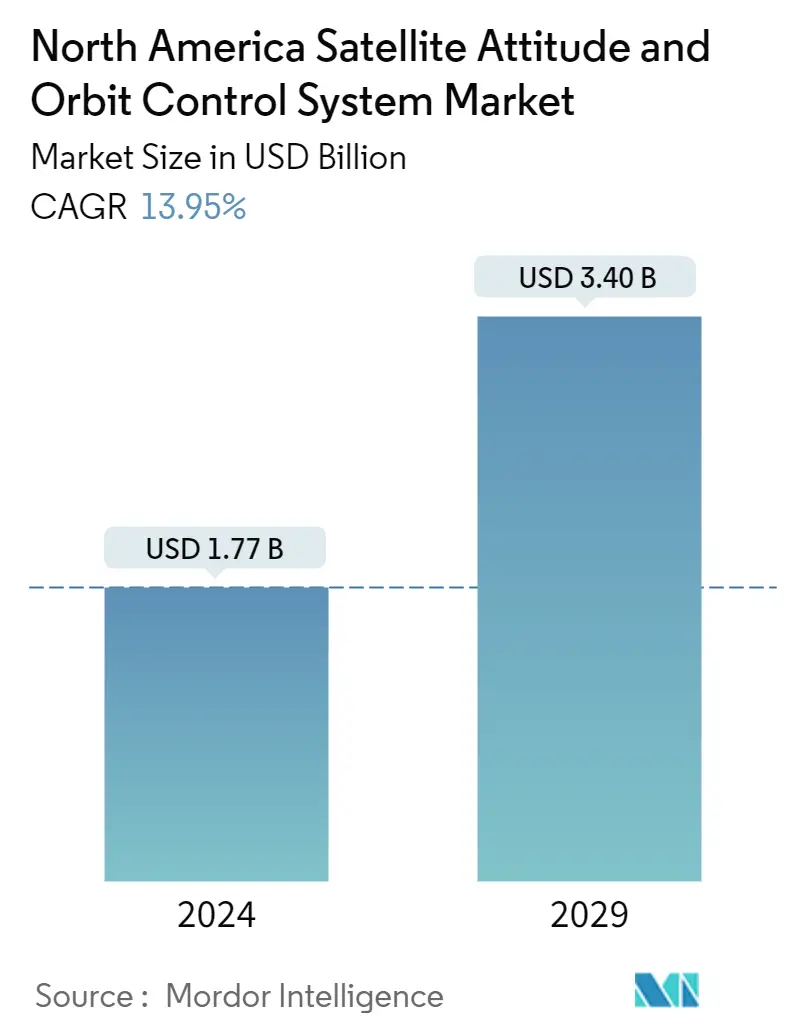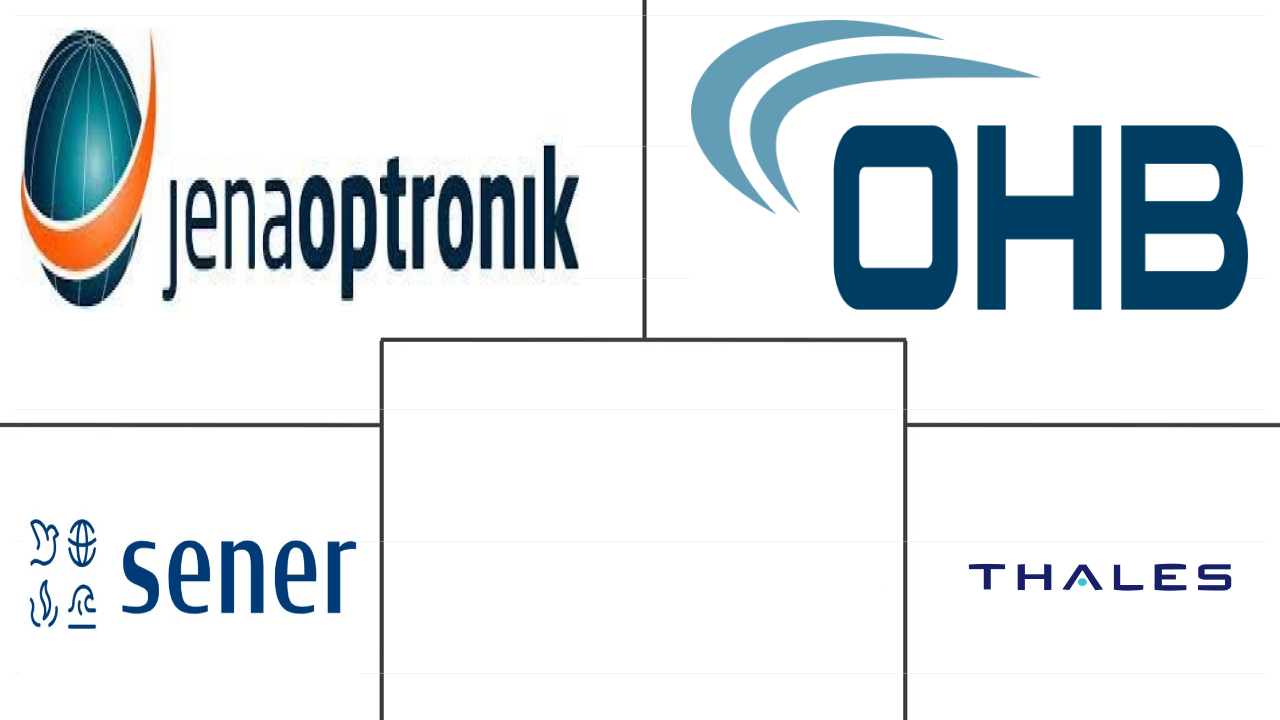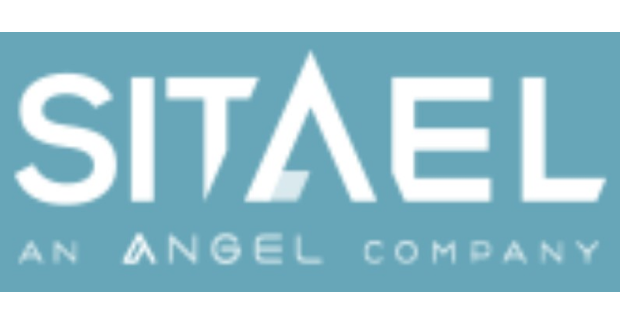Market Size of north america satellite attitude and orbit control system Industry

| Icons | Lable | Value |
|---|---|---|
|
|
Study Period | 2017 - 2029 |
|
|
Market Size (2024) | USD 1.77 Billion |
|
|
Market Size (2029) | USD 3.40 Billion |
|
|
Largest Share by Orbit Class | LEO |
|
|
CAGR (2024 - 2029) | 13.95 % |
|
|
Largest Share by Country | United States |
|
|
Market Concentration | High |
Major Players |
||

|
||
|
*Disclaimer: Major Players sorted in no particular order |
North America Satellite Attitude and Orbit Control System Market Analysis
The North America Satellite Attitude and Orbit Control System Market size is estimated at USD 1.77 billion in 2024, and is expected to reach USD 3.40 billion by 2029, growing at a CAGR of 13.95% during the forecast period (2024-2029).
1.77 Billion
Market Size in 2024 (USD)
3.40 Billion
Market Size in 2029 (USD)
38.21 %
CAGR (2017-2023)
13.95 %
CAGR (2024-2029)
Largest Market by Satellite Mass
65.83 %
value share, 100-500kg, 2022
Minisatellites with expanded capacity for enterprise data (retail and banking), oil, gas, and mining, and governments in developed countries pose high demand. The demand for minisatellites with a LEO is increasing due to their expanded capacity.
Largest Market by Application
78.69 %
value share, Communication, 2022
Governments, space agencies, defense agencies, private defense contractors, and private space industry players are emphasizing the enhancement of the communication network capabilities for various public and military reconnaissance applications.
Largest Market by Orbit Class
72.49 %
value share, LEO, 2022
LEO satellites are increasingly being adopted in modern communication technologies. These satellites serve an important role in Earth observation applications.
Largest Market by End User
69.05 %
value share, Commercial, 2022
The commercial segment is expected to occupy a significant share because of the increasing use of satellites for various telecommunication services.
Leading Market Player
42.69 %
market share, Sitael S.p.A., 2022

SITAEL SpA is the leading player in the market. The company designs and manufactures various satellite parts and components, along with navigation systems such as guidance, navigation, and control systems (AOCS/GNC).
Increasing launches of LEO satellites are driving the market demand
- The satellite AOCS market is experiencing strong growth, driven by the increasing demand for LEO satellites, which are used for communication, navigation, Earth observation, military reconnaissance, and scientific missions. Between 2017 and 2022, approximately 3,021 satellites were launched into LEO. In addition, the demand for AOCS is growing because of the increasing need for high-speed internet access, particularly in rural and remote areas. This has led companies such as SpaceX, OneWeb, and Amazon to plan the launch of thousands of satellites into LEO.
- Additionally, to ensure the proper functioning of GEO satellites, AOCS must perform a range of tasks, including controlling the satellite’s orientation and stabilizing its position. Manufacturers like Honeywell Aerospace provide a range of AOCS products and services for GEO satellites, including the Momentum and Attitude Control System (MACS) and the Digital Star Tracker (DST). Between 2017 and 2022, approximately 33 satellites were launched into GEO.
- In recent years, the military’s use of MEO satellites has grown due to their different advantages, including increased signal strength, improved communications and data transfer capabilities, and greater coverage area. For instance, Raytheon Technologies’ Intelligence & Space and Boeing’s Millennium Space Systems are developing the first prototype Missile Track Custody (MTC) MEO OPIR payloads to detect and track hypersonic missiles for the US Space Force’s SSC that are expected to use various AOCS systems to maintain their orbit. Between 2017 and 2022, approximately seven satellites were launched into MEO. The overall market is expected to grow by 14.77% during 2023-2029.
North America Satellite Attitude and Orbit Control System Industry Segmentation
Communication, Earth Observation, Navigation, Space Observation, Others are covered as segments by Application. 10-100kg, 100-500kg, 500-1000kg, Below 10 Kg, above 1000kg are covered as segments by Satellite Mass. GEO, LEO, MEO are covered as segments by Orbit Class. Commercial, Military & Government are covered as segments by End User.
- The satellite AOCS market is experiencing strong growth, driven by the increasing demand for LEO satellites, which are used for communication, navigation, Earth observation, military reconnaissance, and scientific missions. Between 2017 and 2022, approximately 3,021 satellites were launched into LEO. In addition, the demand for AOCS is growing because of the increasing need for high-speed internet access, particularly in rural and remote areas. This has led companies such as SpaceX, OneWeb, and Amazon to plan the launch of thousands of satellites into LEO.
- Additionally, to ensure the proper functioning of GEO satellites, AOCS must perform a range of tasks, including controlling the satellite’s orientation and stabilizing its position. Manufacturers like Honeywell Aerospace provide a range of AOCS products and services for GEO satellites, including the Momentum and Attitude Control System (MACS) and the Digital Star Tracker (DST). Between 2017 and 2022, approximately 33 satellites were launched into GEO.
- In recent years, the military’s use of MEO satellites has grown due to their different advantages, including increased signal strength, improved communications and data transfer capabilities, and greater coverage area. For instance, Raytheon Technologies’ Intelligence & Space and Boeing’s Millennium Space Systems are developing the first prototype Missile Track Custody (MTC) MEO OPIR payloads to detect and track hypersonic missiles for the US Space Force’s SSC that are expected to use various AOCS systems to maintain their orbit. Between 2017 and 2022, approximately seven satellites were launched into MEO. The overall market is expected to grow by 14.77% during 2023-2029.
| Application | |
| Communication | |
| Earth Observation | |
| Navigation | |
| Space Observation | |
| Others |
| Satellite Mass | |
| 10-100kg | |
| 100-500kg | |
| 500-1000kg | |
| Below 10 Kg | |
| above 1000kg |
| Orbit Class | |
| GEO | |
| LEO | |
| MEO |
| End User | |
| Commercial | |
| Military & Government | |
| Other |
North America Satellite Attitude and Orbit Control System Market Size Summary
The North America Satellite Attitude and Orbit Control System (AOCS) market is poised for significant expansion, driven by the burgeoning demand for Low Earth Orbit (LEO) satellites. These satellites are increasingly utilized for a variety of applications, including communication, navigation, Earth observation, military reconnaissance, and scientific missions. The surge in satellite launches, particularly by companies like SpaceX, OneWeb, and Amazon, underscores the growing need for AOCS to support high-speed internet access, especially in underserved regions. Additionally, the market is witnessing a shift towards small satellites due to their cost-effectiveness and shorter development timelines, which enhance flexibility and responsiveness to technological advancements. This trend is supported by a robust infrastructure in the United States for designing and manufacturing small satellites tailored to specific applications.
The market landscape is characterized by substantial government investment in space programs, with the United States leading globally in expenditure. This financial commitment is reflected in significant contracts awarded to private companies for developing advanced satellite systems, such as those for missile tracking. The Canadian space sector also contributes notably to the region's economy, with a focus on small and medium-sized enterprises. The North America AOCS market is relatively consolidated, with major players like Jena-Optronik, OHB SE, SENER Group, Sitael S.p.A., and Thales dominating the space. Recent developments include contracts for providing AOCS sensors for new satellite platforms, highlighting the ongoing innovation and strategic partnerships within the industry.
North America Satellite Attitude and Orbit Control System Market Size - Table of Contents
-
1. MARKET SEGMENTATION (includes market size in Value in USD, Forecasts up to 2029 and analysis of growth prospects)
-
1.1 Application
-
1.1.1 Communication
-
1.1.2 Earth Observation
-
1.1.3 Navigation
-
1.1.4 Space Observation
-
1.1.5 Others
-
-
1.2 Satellite Mass
-
1.2.1 10-100kg
-
1.2.2 100-500kg
-
1.2.3 500-1000kg
-
1.2.4 Below 10 Kg
-
1.2.5 above 1000kg
-
-
1.3 Orbit Class
-
1.3.1 GEO
-
1.3.2 LEO
-
1.3.3 MEO
-
-
1.4 End User
-
1.4.1 Commercial
-
1.4.2 Military & Government
-
1.4.3 Other
-
-
North America Satellite Attitude and Orbit Control System Market Size FAQs
How big is the North America Satellite Attitude and Orbit Control System Market?
The North America Satellite Attitude and Orbit Control System Market size is expected to reach USD 1.77 billion in 2024 and grow at a CAGR of 13.95% to reach USD 3.40 billion by 2029.
What is the current North America Satellite Attitude and Orbit Control System Market size?
In 2024, the North America Satellite Attitude and Orbit Control System Market size is expected to reach USD 1.77 billion.

